Healthy & Delicious Spaghetti Squash Alfredo: A Lighter Take on a Classic (Gluten-Free & Low-Carb Options)
Indulge in the rich, creamy flavors of alfredo sauce without the heavy feeling or the carb overload! This spaghetti squash alfredo recipe offers a delightfully lightened-up sauce that truly rivals its more traditional, calorie-dense counterpart. If you’re a devoted fan of alfredo but are seeking a healthier alternative that fits into a regular dietary routine, look no further. This recipe is designed to be a guilt-free pleasure, complete with fantastic options for those following gluten-free and grain-free lifestyles.
My first encounter with spaghetti squash as a noodle substitute left me undeniably skeptical. I honestly couldn’t fathom how a vegetable could possibly stand in for beloved pasta. However, smothered in this incredible, velvety alfredo sauce, spaghetti squash proves itself to be an absolute revelation! Its unique texture, which naturally separates into noodle-like strands, perfectly cradles the creamy sauce, creating a dish that is both satisfying and surprisingly light. This isn’t just a compromise; it’s a delicious reinterpretation that you’ll want to make again and again.
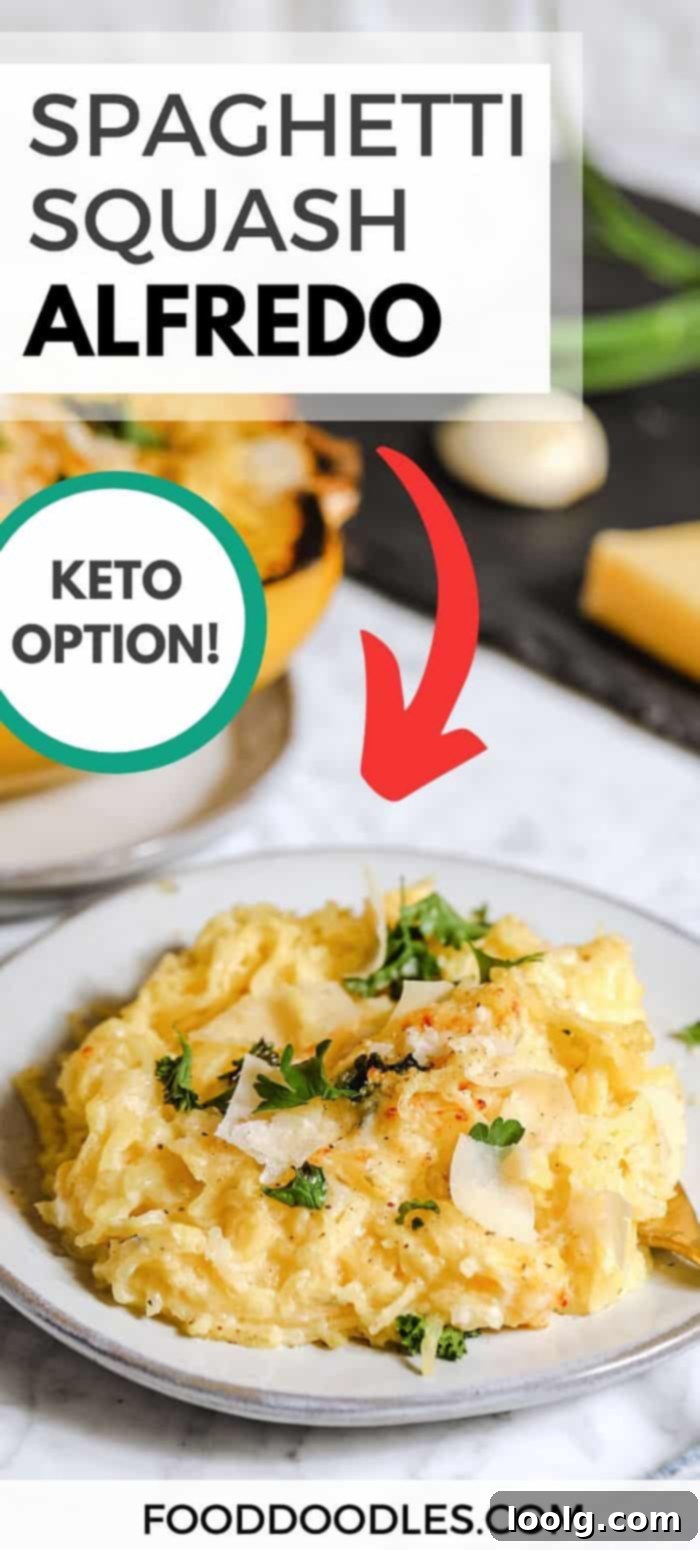
Why Choose Spaghetti Squash Alfredo? A Healthier Indulgence
This recipe holds a special place in my heart because it delivers all the comforting richness of alfredo without the accompanying food coma or the feeling of having overeaten. Traditional fettuccine alfredo, while undeniably tasty, can often leave you sluggish due to its high calorie and carb content. This lighter version, however, allows you to enjoy a generous serving for dinner without the guilt.
When prepared with low-fat cream cheese and 1% milk, a huge half-squash serving (assuming a medium squash yields 6-7 cups of strands) comes in at just over 400 calories. If you opt to serve it as a side dish for four, the calorie count per person drops even further. For those who, like me, prefer the benefits and flavor of full-fat dairy (backed by a number of reasons), the calorie count will be slightly higher, but still remarkably good for such a filling and satisfying meal. It also tastes fantastic with goat butter and a sprinkle of Pecorino Romano for an extra depth of flavor!
Beyond the caloric benefits, the reduced carbohydrate content is a significant advantage. While I can’t definitively label this recipe as strictly “keto” or “low-carb” without precise macros, it is unequivocally *much* lower in carbohydrates than any pasta-based alfredo. This means you can enjoy a hearty meal without the blood sugar spike and subsequent energy crash that often follows a traditional pasta dish. Say goodbye to the post-meal “carb coma” and embrace a dinner that leaves you feeling energized and satisfied.

Mastering the “Noodle” – Cooking Your Spaghetti Squash
The secret to this recipe’s success lies in perfectly cooked spaghetti squash. This versatile vegetable, when cooked, naturally separates into tender, spaghetti-like strands, offering a unique texture that’s both slightly firm and delightfully tender. Here’s how to ensure your spaghetti squash is ready to soak up that luscious alfredo sauce:
Choosing the Right Spaghetti Squash
Look for a squash that feels firm and heavy for its size, with no soft spots or blemishes. The skin should be a uniform pale yellow color. A medium-sized squash typically yields 6-7 cups of strands, perfect for two very generous servings or four side servings.
Two Methods for Cooking Spaghetti Squash: Bake or Microwave
While baking offers a slightly richer flavor, microwaving is a fantastic time-saver, turning this recipe into an incredibly fast weeknight dinner. The sauce itself comes together in just a few minutes, making squash prep the most time-consuming part.
Baking Method (Recommended for deeper flavor)
- Preheat your oven to 350°F (175°C).
- Carefully cut the spaghetti squash in half lengthwise using a large, sharp knife. Be cautious as the squash can be hard to cut.
- Scoop out the seeds and stringy bits from the center of each half.
- Brush a small amount of olive oil (about 1 teaspoon for the whole squash) on the inside flesh of each piece. This helps with caramelization and prevents sticking.
- Place the squash halves cut-side down on a baking sheet.
- Bake for approximately 60 minutes, or until the flesh is tender when pierced with a fork. The exact time will vary depending on the size of your squash.
Microwave Method (For a quick dinner)
If you’re short on time, the microwave is your best friend for cooking spaghetti squash. Here’s a detailed guide on how to cook spaghetti squash in the microwave. Essentially, you’ll poke several deep holes into the squash skin, microwave for 10-15 minutes (or more for larger squash), let it rest, then cut and scoop. This method drastically reduces cooking time, making it ideal for busy evenings.
After Cooking: Preparing the Strands
Once your squash is cooked and slightly cooled (if baked whole, let it rest for 10-20 minutes before cutting), use a fork to gently scrape the “spaghetti” strands from the shell into the center or directly into a bowl. If the strands appear overly watery, you can lightly press them with a paper towel or a clean tea towel to drain any excess liquid. However, this is rarely necessary in my experience.
Crafting the Creamy, Lightened-Up Alfredo Sauce
The heart of this dish is its incredibly delicious and lighter alfredo sauce. Unlike traditional versions that rely heavily on copious amounts of butter and heavy cream, this recipe achieves remarkable creaminess with smart ingredient choices that don’t sacrifice flavor.
Key Ingredients for a Lighter Alfredo
- **Butter:** A small amount of butter forms the base for our roux, providing a foundational richness.
- **Flour (Roux Base):** This is where you have flexibility.
- **All-purpose or whole wheat flour:** These work perfectly for a classic thickener.
- **Cassava flour (for Gluten-Free & Grain-Free):** If you need a gluten-free or grain-free option, Bob’s Red Mill cassava flour is my go-to. Note that you’ll need slightly less cassava flour than wheat flour, and the roux might appear a bit crumbly, but rest assured, the sauce will still come together beautifully. I can only guarantee results with Bob’s Red Mill as different brands of cassava flour can behave differently.
- **Garlic:** Freshly minced, grated, or pressed garlic is essential for that signature alfredo aroma and flavor. Don’t skip it!
- **Cream Cheese:** This is the secret ingredient for a lighter yet incredibly creamy texture. It provides a lovely tang and body without the need for heavy cream. You can use full-fat or low-fat cream cheese depending on your dietary preference; both yield excellent results.
- **Milk:** 1% or 2% milk is used to thin and create the base of the sauce, keeping it lighter than heavy cream.
- **Parmesan Cheese:** Freshly grated Parmesan is non-negotiable for authentic alfredo flavor. It melts beautifully into the sauce, adding saltiness and umami. I find that freshly grated Parmesan provides a superior texture and flavor compared to pre-shredded options. If using pre-shredded, be aware that the volume measurement might differ, so going by weight (60 grams) is always recommended.
- **Salt:** A touch of salt enhances all the flavors. While this recipe isn’t the absolute lowest in sodium, if your other meals are typically home-cooked and low-sodium, it’s a perfectly acceptable indulgence.
The Sauce-Making Process
The sauce comes together quickly, making it a perfect last-minute component once your spaghetti squash is cooked. Melt the butter, sauté the garlic briefly to release its aroma, then whisk in the flour to form a roux. After incorporating the cream cheese and melting it in, gradually add the milk while whisking vigorously to prevent lumps. Bring it to a gentle simmer to thicken, then remove from heat and stir in the Parmesan and salt until smooth and creamy. The entire sauce can be made in just a few minutes, proving that delicious and light doesn’t have to mean complicated.
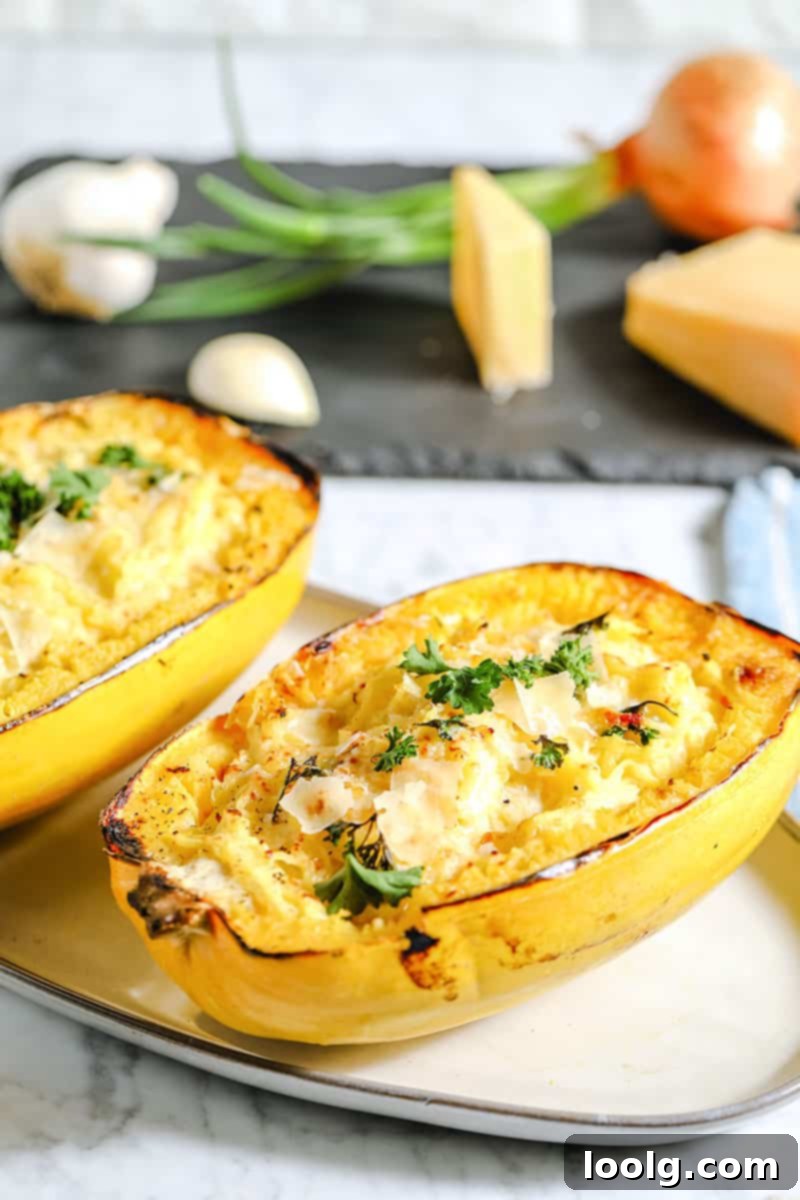
Customizing and Serving Your Spaghetti Squash Alfredo
Once your spaghetti squash is tender and your alfredo sauce is silky smooth, it’s time to bring them together and add your personal touch!
Combining and Broiling for Perfection
You can choose to serve your spaghetti squash alfredo in its original “shells” for a beautiful presentation. Simply pour half of the sauce into each squash half and gently stir to combine the strands with the creamy sauce. For an extra layer of flavor and a beautiful golden crust, I love to sprinkle a little extra Parmesan (or even some mozzarella!) on top and pop them under the broiler for 2-3 minutes until bubbly and slightly golden. This step is completely optional, though, if you’re short on time. Alternatively, for an even simpler approach, just scrape all the cooked squash strands into a large pot with your sauce, stir well, and serve.
Delicious Additions and Side Pairings
This spaghetti squash alfredo is wonderfully versatile. Here are a few ideas to elevate your meal:
- **Garnishes:** A sprinkle of fresh parsley adds brightness, while red pepper flakes provide a gentle kick.
- **Proteins:** For a more complete meal, consider adding cooked chicken, shrimp, or even chunks of ham. They all pair beautifully with the creamy alfredo sauce.
- **Side Dishes:** A crisp Caesar salad offers a refreshing counterpoint, and roasted broccoli with lemon, garlic, and Parmesan cheese would be an absolutely fantastic accompaniment.
No matter how you choose to customize and serve it, I’m confident you’ll enjoy this lighter alfredo just as much as we do. It’s a truly satisfying dish that proves healthy eating can still be incredibly flavorful.
Frequently Asked Questions About Spaghetti Squash Alfredo
Is this recipe truly keto or low-carb?
While this recipe is significantly lower in carbohydrates compared to traditional pasta alfredo, whether it fits a strict keto diet depends on your specific carb limits and the ingredients you choose. Using full-fat dairy and adjusting the flour type (e.g., sticking to cassava flour or an even lower-carb thickener if preferred) will make it more keto-friendly. Always calculate your macros based on the ingredients you use if following a strict diet.
Can I prepare spaghetti squash ahead of time?
Yes, you can cook the spaghetti squash ahead of time. Once cooked and scraped, store the strands in an airtight container in the refrigerator for up to 3-4 days. You can also make the alfredo sauce a day in advance and reheat it gently on the stovetop, whisking well to restore its creaminess.
What if my spaghetti squash is watery?
While rare with this cooking method, some spaghetti squash can be more watery than others. If you find your strands are very moist, simply place them in a colander and press gently with a clean kitchen towel or paper towels to absorb excess moisture before combining with the sauce.
What exactly is a “stripetti squash”?
Funnily enough, the squash I used for some of the photos was actually labeled “stripetti squash” at the market, which I initially thought was just a variation of spaghetti squash. Turns out, it’s a hybrid of spaghetti squash and delicata squash! Spaghetti squash can still be hard to find where I live in Germany, so I was incredibly fortunate to find this one. Despite the name, its interior looks and cooks just like a regular spaghetti squash, yielding those characteristic spaghetti-like strands. So don’t worry if you come across a “stripetti” – it will work perfectly in this recipe!
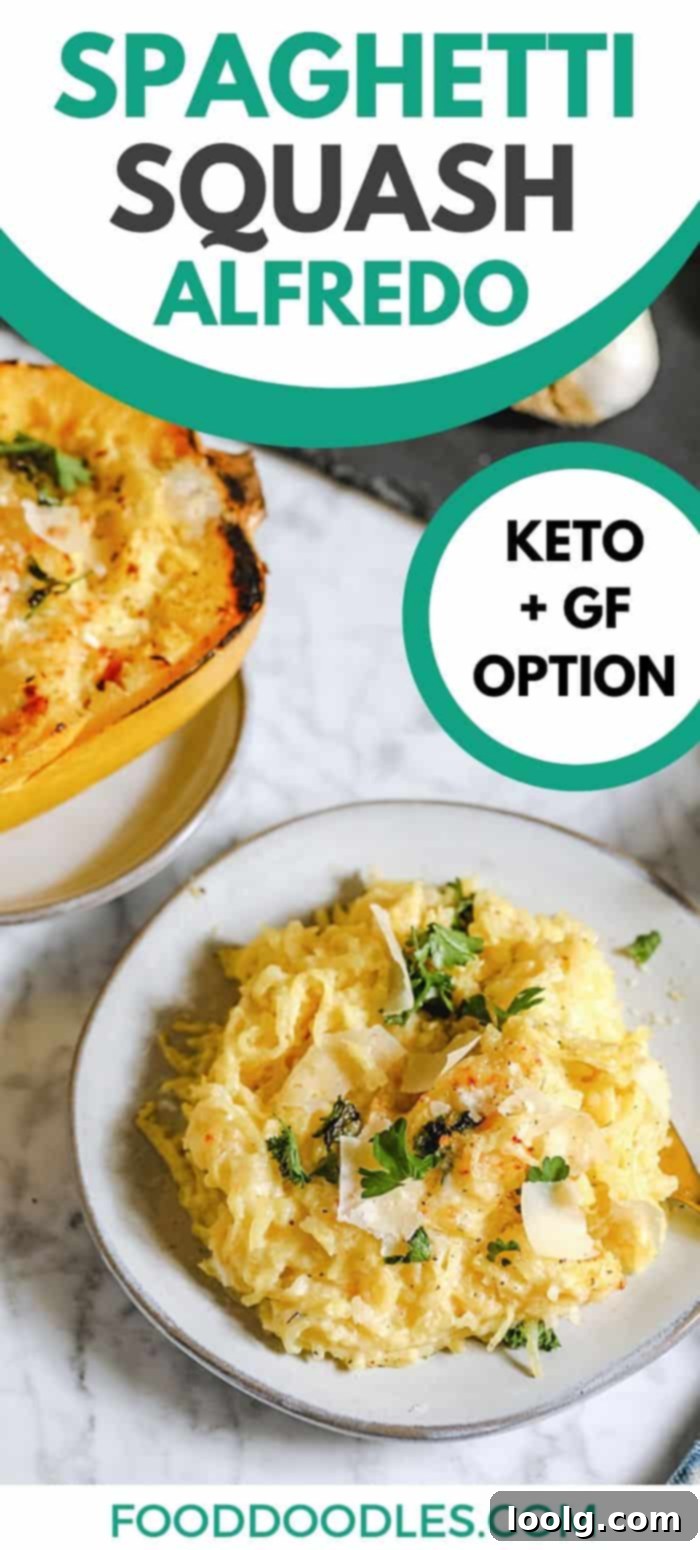
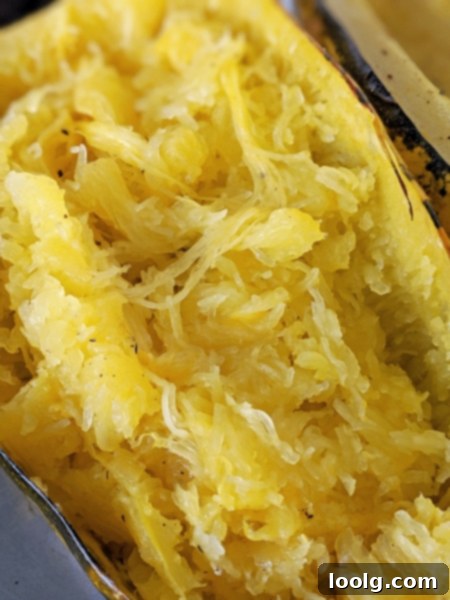
More Healthy & Delicious Recipes to Try
If you’ve enjoyed this cheesy squash dish and are looking for other comforting, wholesome recipes, I highly recommend trying my pumpkin macaroni and cheese. It’s another fantastic way to incorporate vegetables into a beloved classic, offering a unique flavor profile that’s perfect for cozy meals.
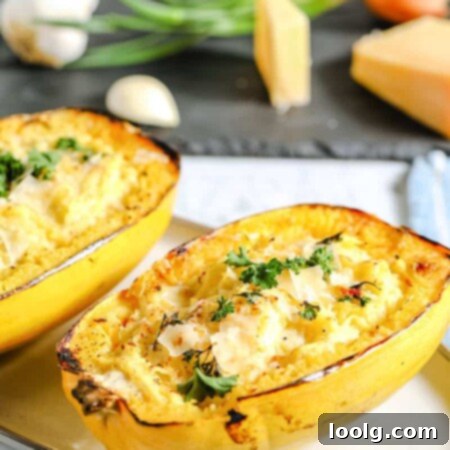
Spaghetti Squash Alfredo (gluten-free, grain-free options)
Ingredients
- 1 teaspoon olive oil (or another oil)
- 1 medium spaghetti squash
- 1 tablespoon (14 grams) butter
- 2 1/2 tablespoon (20 grams) all-purpose flour or whole wheat flour or 2 tablespoons Bob’s Red Mill cassava flour for gluten-free and grain-free
- 2-3 cloves of garlic very finely minced, grated or pressed
- 1 tablespoon (15 grams) cream cheese
- 1 1/2 cups (355 ml) milk
- 1/2-1 cup (60 grams) freshly grated Parmesan, plus extra for topping
- 1/4 teaspoon salt
Instructions
-
First prep the spaghetti squash. Preheat the oven to 350 °F (175 °C). Cut the spaghetti squash in half using a large sharp knife, scoop out the seeds, and brush a little olive oil on the inside of each piece. Place the cut side down on a baking sheet.
-
Bake until tender, about an hour. Alternatively, keep the spaghetti squash whole. Poke a few holes deep into the squash with a large knife. Place in the oven whole. Bake for 60 minutes, remove from the oven and let rest for 10 to 20 minutes before slicing in half with a large serrated knife like a bread knife. Scoop out the seedy inside leaving the spaghetti strands.
-
Once cooked, use a fork to gently scrape the “spaghetti” strands into the center. If they seem overly watery, use a tea towel / paper towel to drain the liquid (this rarely is needed when I make it).
-
For the sauce, melt the butter in a small pot. Once hot add the garlic and saute for 1-2 minutes over medium-low heat. Add the flour and whisk into the butter (if using cassava, it may look crumbly). Cook for another minute while stirring. Add the cream cheese and stir it into the butter mixture.
-
Add the milk and whisk well. Bring up to a gentle simmer, cook until thickened, then remove from the heat. Add the freshly grated cheese and salt and stir until melted, just a minute or two. Pour half the sauce into each spaghetti squash half (or less if using a smaller squash). Gently stir to combine. Top with an extra sprinkle of Parmesan and place under the broiler of your oven for 2-3 minutes until golden and bubbly. Serve immediately.
Notes
Nutrition
Pictures on this post were updated in September 2019 to reflect improved food photography. This is what some of them looked like before:

